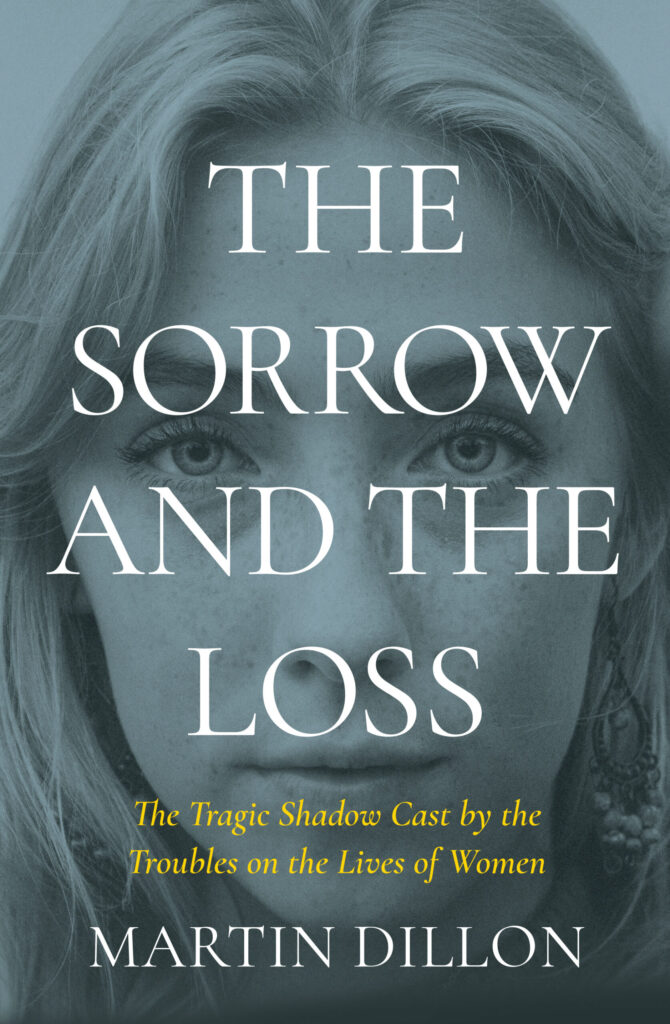MARTIN DILLON
Merrion Press
€19.99
ISBN 9781785375415
REVIEWED BY
Margaret Ward
Margaret Ward is Hon. Senior Lecturer in History at Queen’s University, Belfast, and author of Rebel women: Cumann na mBan in Belfast and the Glens of Antrim 1914–1924 (Beyond the Pale Books, 2024).
Martin Dillon is an investigative journalist whose exhaustive exploration of the underbelly of the conflict in the North has exposed the horrors of the Shankill Butchers, the ruthless worlds of terrorism and counter-terrorism, and the dirty tricks of the British security forces. Over the decades he has amassed an unrivalled body of sources from all political persuasions. He is not, however, an author associated with exploration of the impact of political conflict on the lives of women. His latest book, The sorrow and the loss, aims to remedy this, as he states his intention to ‘give voice to a diverse group of women from different backgrounds’ as they ‘shared with me their first-hand experiences, painful memories and political beliefs’. The book focuses on a wide spectrum of women, from survivors of bombings, girlfriends of paramilitaries, political activists and IRA members to women left shattered by the brutal loss of fathers and sons. Loyalists, republicans, policewomen, women from both sides of the border and one from a British army background are included.
Dillon’s particular strength is his inside knowledge of loyalist paramilitarism, and he provides insight into the turbulent, violent, drug-fuelled world of Shankill Road loyalism in the sad life story of Tracey Coulter, daughter of a UDA commander and partner of ‘Top Gun’ McKeag, credited with the murders of possibly up to twenty Catholics. There are also short but poignant chapters on the Dublin bombing, where Bernie O’Hanlon lost an eye; the impact on seven-and-a-half-year-old Serena Graham of the murder of her UDR father; Paula Fox’s determination to discover the truth behind the murder of her father, former IRA prisoner Leonard Fox, murdered while working as a builder in the loyalist Ballybeen estate; Jean McBride’s decades-long campaign to bring to justice the British soldiers who shot her son Peter in the back as he walked home to the New Lodge, carrying only a T-shirt in a plastic bag; the impact on the young daughters of two Catholic judges, Tom Travers and Rory Conaghan, murdered by the IRA; a newly married wife of a British soldier blown up while on foot patrol in County Armagh; Tracy Doak, an RUC officer whose car was blown up by a bomb so powerful her remains could not be recovered; and Stella Robinson’s recall of the Cenotaph massacre in Enniskillen, when both of her parents were killed and her brother injured. The story of the Kane family, whose father Edward was one of the victims of the bombing of McGurk’s bar, is particularly powerful. Dillon describes the impact on his widow and children, and the shocking cover-up by the security forces to conceal the identity of the loyalist perpetrators. The legacy of the Troubles and the urgency to find out the truth remain as vital as ever, despite the British government’s reluctance to provide any meaningful mechanism for this to begin. Much of this is a reworking of previous research. There is some sloppiness too. We are told that Jean McBride worked with her lawyers at the ‘Finucane Centre’, when she presumably worked with the lawyers of the respected Madden and Finucane legal firm rather than the Derry-based human rights organisation, the Pat Finucane Centre.
Although Dillon claims that his book describes ‘raw and compelling testimonies’ as women ‘share their stories’, his choice of female republican activists is concentrated on women long deceased and therefore unable to tell their own story. Mairead Farrell was shot dead in Gibraltar in 1988; Caroline Morehead was murdered in 1994; the notorious ‘Boston tapes’ are used for Dolours Price, adding nothing to extensive coverage elsewhere, most recently by Radden Keefe in Say nothing and the subsequent Netflix series, while Martina Anderson (whom Dillon insists on describing as the ‘Beauty Queen’ bomber) declined to be interviewed. The fate of lawyer Rosemary Nelson, murdered by loyalists in 1999, is refracted mainly through Dillon’s knowledge of the LVF in Lurgan. Bernadette McAliskey (‘A political firebrand’) and her daughter Roisin are featured in a lengthy chapter written entirely as indirect testimony.
Dillon’s lack of knowledge of republican women’s history is evident when he claims that the Armagh women’s hunger strike was called in solidarity with Bobby Sands and his fellow hunger strikers, ending ‘a day after the one in the Maze was called off following the deaths of ten men’. If that was the case, then the women would have outdone the men on days spent on hunger strike. The reality was that three women were on hunger strike between 1 and 19 December 1980, during the first hunger strike led by Brendan Hughes.
In The dirty war Dillon revealed the existence of secret burials of those who came to be known as ‘the disappeared’, and this knowledge is used again in descriptions of the fate of Columba McVeigh and Jean McConville. Dympna Kerr, Columba’s sister, spoke to Dillon in January 2024, but the majority of this section rehashes what is now widely known, including the various theories on why Jean McConville came to be one of the disappeared.
For a historian the book can be infuriating, lacking any sources, references or information on when and where interviews took place, and possessing no index. It is not an oral history of the impact of the Troubles on the lives of women but a journalistic account of how a selection of women’s lives were irrevocably impacted by the actions of (mainly) men from paramilitary and military organisations, coupled with an examination of some republican women whose activities also had an impact on others.

